.gif)
Vaishali (ancient city)
Encyclopedia
Vaiśālī also called Nagari , is an abugida alphabet of India and Nepal...
: वैशाली) was the capital city of the Licchavi, one of world's first republic
Republic
A republic is a form of government in which the people, or some significant portion of them, have supreme control over the government and where offices of state are elected or chosen by elected people. In modern times, a common simplified definition of a republic is a government where the head of...
s, in the Vajjian Confederacy
Vajji
Vajji or Vrijji was one of the principal Mahajanapadas of ancient India. Both the Buddhist text Anguttara Nikaya and the Jaina text Bhagavati Sutra included Vajji in their lists of solasa Maha-Janapadas. The name of this Mahajanapada was derived from one of its ruling clans, the Vṛjis...
(Vrijji) mahajanapada, around the 6th century BC. It was here in 599 BCE the 24th Jain Tirthankara, Bhagwan Mahavira
Mahavira
Mahāvīra is the name most commonly used to refer to the Indian sage Vardhamāna who established what are today considered to be the central tenets of Jainism. According to Jain tradition, he was the 24th and the last Tirthankara. In Tamil, he is referred to as Arukaṉ or Arukadevan...
was born and brought up in Kundalagrama in Vaiśālī republic, which make pious & auspicious pilgrimage to Jainist. Also Gautama Buddha
Gautama Buddha
Siddhārtha Gautama was a spiritual teacher from the Indian subcontinent, on whose teachings Buddhism was founded. In most Buddhist traditions, he is regarded as the Supreme Buddha Siddhārtha Gautama (Sanskrit: सिद्धार्थ गौतम; Pali: Siddhattha Gotama) was a spiritual teacher from the Indian...
preached his last sermon before his death in ca 483 BCE, then in 383 BCE the Second Buddhist council
Second Buddhist council
The Second Buddhist council took place approximately one hundred years after the Buddha's parinirvāṇa. Virtually all scholars agree that the second council was a historical event...
was convened here by King Kalasoka, making it an important place in both Jain & Buddhist religions.
At the time of the Buddha
Buddha
In Buddhism, buddhahood is the state of perfect enlightenment attained by a buddha .In Buddhism, the term buddha usually refers to one who has become enlightened...
, Vaiśālī, which he visited on many occasions, was a very large city, rich and prosperous, crowded with people and with abundant food. There were 7,707 pleasure grounds and an equal number of lotus ponds. Its courtesan, Amrapali, was famous for her beauty, and helped in large measure in making the city prosperous. The city had three walls, each one gāvuta away from the other, and at three places in the walls were gates with watch towers. Outside the town, leading uninterruptedly up to the Himalaya, was the Mahavana, a large, natural forest. Nearby were other forests, such as Gosingalasāla.
The city finds mention in the travel accounts of Chinese explorers, Faxian
Faxian
Faxian was a Chinese Buddhist monk who traveled to India, Sri Lanka and Kapilavastu in today's Nepal between 399 and 412 to acquire Buddhist scriptures...
(4th century CE) and Xuanzang
Xuanzang
Xuanzang was a famous Chinese Buddhist monk, scholar, traveler, and translator who described the interaction between China and India in the early Tang period...
(7th century CE), which were later used in 1861 by British archaeologist Alexander Cunningham
Alexander Cunningham
Sir Alexander Cunningham KCIE CSI was a British archaeologist and army engineer, known as the father of the Archaeological Survey of India...
to first identify Vaiśālī with the present village of Basrah in Vaishali District
Vaishali District
Vaishali District is a district in Bihar state, India. It is named after the Vaishali . The history of Vaishali district is thus very ancient, and finds mention in the Indian classic Mahabharata, as well as in Buddhist and Jain tradition....
, Bihar
Bihar
Bihar is a state in eastern India. It is the 12th largest state in terms of geographical size at and 3rd largest by population. Almost 58% of Biharis are below the age of 25, which is the highest proportion in India....
.
Etymology
Vaiśālī derives its name from King VishalKing Vishal
King Vishal was a king of ancient India, son of Ikshwaku queen Alambusha. Vaishali is supposed to have got its name from King Visal, who ruled on this land. It was named Vishalapuri after the king. With time the name changed to Vaishali....
of the Mahabharata
Mahabharata
The Mahabharata is one of the two major Sanskrit epics of ancient India and Nepal, the other being the Ramayana. The epic is part of itihasa....
age. The city was also called Visālā. Buddhaghosa
Buddhaghosa
Bhadantācariya Buddhaghoṣa(Chinese: 覺音)was a 5th-century Indian Theravadin Buddhist commentator and scholar. His best-known work is the Visuddhimagga, or Path of Purification, a comprehensive summary and analysis of the Theravada understanding of the Buddha's path to liberation...
, the a 5th-century Indian Theravadin Buddhist commentator and scholar says, that Vesali was so called because it was extensive or Vishal
Vishal
Vishal may refer to:* Vishal , a common given Indian name, from Hindi/ Sanskrit, meaning massive, pertaining to dimensions and hence strength.People:* Vishal Arora, Indian journalist* Vishal Bhardwaj, Indian music composer...
.
History

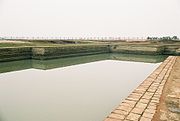
Buddhism
Buddhism is a religion and philosophy encompassing a variety of traditions, beliefs and practices, largely based on teachings attributed to Siddhartha Gautama, commonly known as the Buddha . The Buddha lived and taught in the northeastern Indian subcontinent some time between the 6th and 4th...
and Jainism
Jainism
Jainism is an Indian religion that prescribes a path of non-violence towards all living beings. Its philosophy and practice emphasize the necessity of self-effort to move the soul towards divine consciousness and liberation. Any soul that has conquered its own inner enemies and achieved the state...
, Vaiśālī was the capital of the vibrant republic
Republic
A republic is a form of government in which the people, or some significant portion of them, have supreme control over the government and where offices of state are elected or chosen by elected people. In modern times, a common simplified definition of a republic is a government where the head of...
an Licchavi
Licchavi
Licchavi was an ancient kingdom in Nepal, which existed in the Kathmandu Valley from approximately 400 to 750. Centuries earlier, at the start of the Buddhist era a powerful republic known as Licchavi existed in what is today Bihar. There is no conclusive evidence of any ethnic or historic links...
state
Sovereign state
A sovereign state, or simply, state, is a state with a defined territory on which it exercises internal and external sovereignty, a permanent population, a government, and the capacity to enter into relations with other sovereign states. It is also normally understood to be a state which is neither...
. In that period, Vaiśālī was an ancient metropolis
Metropolis
A metropolis is a very large city or urban area which is a significant economic, political and cultural center for a country or region, and an important hub for regional or international connections and communications...
and the capital city
Capital City
Capital City was a television show produced by Euston Films which focused on the lives of investment bankers in London living and working on the corporate trading floor for the fictional international bank Shane-Longman....
of the republic of the Vaiśālī state, which covered most of the Himalayan
Himalayas
The Himalaya Range or Himalaya Mountains Sanskrit: Devanagari: हिमालय, literally "abode of snow"), usually called the Himalayas or Himalaya for short, is a mountain range in Asia, separating the Indian subcontinent from the Tibetan Plateau...
Gangetic region of present-day Bihar
Bihar
Bihar is a state in eastern India. It is the 12th largest state in terms of geographical size at and 3rd largest by population. Almost 58% of Biharis are below the age of 25, which is the highest proportion in India....
state, India. However, very little is known about the early history of Vaiśālī. The Vishnu Purana
Vishnu Purana
The Vishnu Purana is a religious Hindu text and one of the eighteen Mahapuranas. It is considered one of the most important Puranas and has been given the name Puranaratna...
records 34 king
Monarch
A monarch is the person who heads a monarchy. This is a form of government in which a state or polity is ruled or controlled by an individual who typically inherits the throne by birth and occasionally rules for life or until abdication...
s of Vaiśālī, the first being Nabhaga, who is believed to have abdicated
Abdication
Abdication occurs when a monarch, such as a king or emperor, renounces his office.-Terminology:The word abdication comes derives from the Latin abdicatio. meaning to disown or renounce...
his throne
Throne
A throne is the official chair or seat upon which a monarch is seated on state or ceremonial occasions. "Throne" in an abstract sense can also refer to the monarchy or the Crown itself, an instance of metonymy, and is also used in many expressions such as "the power behind the...
over a matter of human rights
Human rights
Human rights are "commonly understood as inalienable fundamental rights to which a person is inherently entitled simply because she or he is a human being." Human rights are thus conceived as universal and egalitarian . These rights may exist as natural rights or as legal rights, in both national...
and believed to have declared: "I am now a free tiller of the soil, king over my acre." The last among the 34 was Sumati, who is considered a contemporary of Dasaratha
Dasaratha
Dasharatha was a king of Ayodhya of the Ikshvaku dynasty whose life story is narrated principally in the Hindu epic Ramayana...
, father of the Hindu
Hindu
Hindu refers to an identity associated with the philosophical, religious and cultural systems that are indigenous to the Indian subcontinent. As used in the Constitution of India, the word "Hindu" is also attributed to all persons professing any Indian religion...
god, Lord Rama.
In the republic of Vaiśālī, Lord Mahavira
Mahavira
Mahāvīra is the name most commonly used to refer to the Indian sage Vardhamāna who established what are today considered to be the central tenets of Jainism. According to Jain tradition, he was the 24th and the last Tirthankara. In Tamil, he is referred to as Arukaṉ or Arukadevan...
was born. Gautama Buddha
Gautama Buddha
Siddhārtha Gautama was a spiritual teacher from the Indian subcontinent, on whose teachings Buddhism was founded. In most Buddhist traditions, he is regarded as the Supreme Buddha Siddhārtha Gautama (Sanskrit: सिद्धार्थ गौतम; Pali: Siddhattha Gotama) was a spiritual teacher from the Indian...
delivered his last sermon at Vaiśālī and announced his Parinirvana
Parinirvana
In Buddhism, parinirvana is the final nirvana, which occurs upon the death of the body of someone who has attained complete awakening...
there. Vaiśālī is also renowned as the land of Ambapali
Ambapali
Amrapāli, also known as "Ambapālika" or "Ambapali", was a nagarvadhu of the republic of Vaishali in ancient India around 500 BC.. Following the Buddha's teachings she became an arahant...
(also spelled as Amrapali), the great Indian courtesan
Courtesan
A courtesan was originally a female courtier, which means a person who attends the court of a monarch or other powerful person.In feudal society, the court was the centre of government as well as the residence of the monarch, and social and political life were often completely mixed together...
, who appears in many folktales, as well as in Buddhist literature
Literature
Literature is the art of written works, and is not bound to published sources...
. Ambapali became a disciple of Buddha
Gautama Buddha
Siddhārtha Gautama was a spiritual teacher from the Indian subcontinent, on whose teachings Buddhism was founded. In most Buddhist traditions, he is regarded as the Supreme Buddha Siddhārtha Gautama (Sanskrit: सिद्धार्थ गौतम; Pali: Siddhattha Gotama) was a spiritual teacher from the Indian...
.
A kilometre away is Abhishek Pushkarini, the coronation tank. The sacred waters of the tank anointed the elected representatives of Vaiśālī. Next to it stands the Japanese temple and the Vishwa Shanti Stupa (World Peace Pagoda) built by the Nipponzan Myohoji sect of Japan. A small part of the Buddha's relics found in Vaiśālī have been enshrined in the foundation and in the chhatra of the Stupa.
Near the coronation tank is Stupa 1 or the Relic Stupa. Here the Lichchavis reverentially encased one of the eight portions of the Master's relics, which they received after the Mahaparinirvana. After his last discourse the Awakened One set out for Kushinagar
Kushinagar
Kushinagar , Kusinagar or Kusinara is a town and a nagar panchayat in Kushinagar district in the Indian state of Uttar Pradesh. It is an important Buddhist pilgrimage site, where Gautama Buddha is believed to have attained Parinirvana after his death.-Demographics: India census, Kushinagar had a...
, but the Licchavi
Licchavi
Licchavi was an ancient kingdom in Nepal, which existed in the Kathmandu Valley from approximately 400 to 750. Centuries earlier, at the start of the Buddhist era a powerful republic known as Licchavi existed in what is today Bihar. There is no conclusive evidence of any ethnic or historic links...
s kept following him. Buddha gave them his alms bowl but they still refused to return. The Master created an illusion of a river in spate which compelled them to go back. This site can be identified with Deora in modern Kesariya village, where Ashoka
Ashoka
Ashok Maurya or Ashoka , popularly known as Ashoka the Great, was an Indian emperor of the Maurya Dynasty who ruled almost all of the Indian subcontinent from ca. 269 BC to 232 BC. One of India's greatest emperors, Ashoka reigned over most of present-day India after a number of military conquests...
later built a stupa. Ānanda
Ananda
Ānanda was one of the principal disciples and a devout attendant of the Buddha. Amongst the Buddha's many disciples, Ānanda had the most retentive memory and most of the suttas in the Sutta Pitaka are attributed to his recollection of the Buddha's teachings during the First Buddhist Council...
, the favourite disciple of the Buddha, attained Nirvana in the midst of the Ganges outside Vaiśālī.
Visits of the Buddha to Vaiśālī
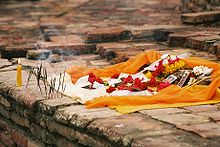
Bodhi
Bodhi is both a Pāli and Sanskrit word traditionally translated into English with the word "enlightenment", but which means awakened. In Buddhism it is the knowledge possessed by a Buddha into the nature of things...
, and spent the rainy season there. The Buddhist Theravadin
Theravada
Theravada ; literally, "the Teaching of the Elders" or "the Ancient Teaching", is the oldest surviving Buddhist school. It was founded in India...
Commentaries give detailed descriptions of the circumstances of this visit. Vesāai was inhabited by seven thousand and seven raja
Raja
Raja is an Indian term for a monarch, or princely ruler of the Kshatriya varna...
s, each of whom had large retinues, many palaces and pleasure parks. There came a shortage in the food supply owing to drought, and people died in large numbers. The smell of decaying bodies attracted evil spirits, and many inhabitants were attacked by intestinal disease. The people complained to the ruling prince, and he convoked a general assembly, where it was decided, after much discussion, to invite the Buddha to their city. As the Buddha was then at Veluvana in Rājagṛha
Rajgir
Rajgir is a city and a notified area in Nalanda district in the Indian state of Bihar. The city of Rajgir was the first capital of the kingdom of Magadha, a state that would eventually evolve into the Mauryan Empire. Its date of origin is unknown, although ceramics dating to about 1000 BC have...
, the Licchavi Mahāli, friend of King Bimbisara
Bimbisara
Bimbisara was a King, and later, Emperor of the Magadha empire from 543 BC to his death and belonged to the Hariyanka dynasty.-Career:There are many accounts of Bimbisara in the Jain texts and the Buddhist Jatakas, since he was a contemporary of Mahavira and Gautama Buddha. He was the king of...
and son of the chaplain of Vesali, was sent to Bimbisara with a request that he should persuade the Buddha to go to Vaiśālī.
Bimbisāra referred him to the Buddha himself, who, after listening to Mahāli's story, agreed to go. The Buddha started on the journey with five hundred monks. Bimbisāra decorated the route from Rājagṛha to the Ganges, a distance of five leagues, and provided all comforts on the way. He accompanied the Buddha, and the Ganges was reached in five days. Boats, decked with great splendour, were ready for the Buddha and his monks, and we are told that Bimbisāra followed the Buddha into the water up to his neck. The Buddha was received on the opposite bank by the Licchavis, with even greater honour than Bimbisāra had shown him. As soon as the Buddha set foot in the Vajjian territory, there was a thunderstorm and rain fell in torrents. The distance from the Ganges to Vaiśālī was three leagues; as the Buddha approached Vaiśālī, Sakka came to greet him, and, at the sight of the devas, all the evil spirits fled in fear. In the evening the Buddha taught Ānanda the Ratana Sutta
Ratana Sutta
The Ratana Sutta is a Buddhist discourse found in the Pali Canon's Sutta Nipata and Khuddakapatha ; with a parallel in the Mahavastu. In the Pali it is seventeen verses in length, and in the Sanskrit version nineteen...
, and ordered that it should be recited within the three walls of the city, the round of the city being made with the Licchavi princes. This Ānanda did during the three watches of the night, and all the pestilences of the citizens disappeared. The Buddha himself recited the Ratana Sutta to the assembled people, and eighty four thousand beings were converted. After repeating this for seven consecutive days, the Buddha left Vaiśālī. (According to the DhA. account the Buddha stayed only seven days in Vaiśālī; KhA. says two weeks). The Licchavis accompanied him to the Ganges with redoubled honours, and, in the river itself, Devas and Nāgas vied with each other in paying him honour. On the farther bank, Bimbisāra awaited his arrival and conducted him back to Rājagṛha. On his return there, the Buddha recited the Sankha Jātaka.
It is not possible to know how many visits were paid by the Buddha to Vaiśālī, but the books would lead us to infer that they were several. Various Vinaya rules are mentioned as having been laid down at Vaiśālī. The visit mentioned in the last context seems to have been a long one; it was on this occasion that the Buddha ordered the monks to turn their bowls upon the Licchavi Vaddha. Also other Vinaya rules were laid down at Vaiśālī. It was during a stay in Vaiśālī, whither he had gone from Kapilavatthu, that Mahapajapati Gotami
Mahapajapati Gotami
Mahāpajābatī Gotamī was the first woman to request ordination from the Buddha and to join the Saṅgha...
followed the Buddha with five hundred other Sakya
Sakya
The Sakya school is one of four major schools of Tibetan Buddhism, the others being the Nyingma, Kagyu, and Gelug...
n women, and, with the help of Ānanda's intervention, obtained permission for women to enter the Order under certain conditions.
The books describe at some length the Buddha's last visit to Vesali on his way to Kusinara. On the last day of this visit, after his meal, he went with Ānanda to Cāpāla cetiya for his siesta, and, in the course of their conversation, he spoke to Ānanda of the beauties of Vaiśālī: of the Udena cetiya, the Gotamaka cetiya, the Sattambaka cetiya, the Bahuputta cetiya, and the Sārandada cetiya, where a Kapinayha-cetiya is also mentioned. All these were once shrines dedicated to various local deities, but after the Buddha's visit to Vaiśālī, they were converted into places of Buddhist worship. Other monasteries are also mentioned, in or near Vaiśālī (for example Pātikārāma, Vālikārāma).
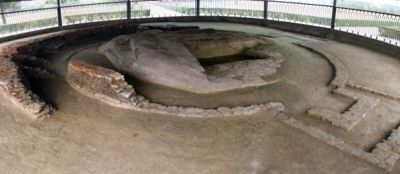
Vassa
Vassa , also called Rains Retreat, or Buddhist Lent, is the three-month annual retreat observed by Theravada practitioners...
, Ambapāli invited the Buddha and the monks to a meal, at the conclusion of which she gave her Ambavana for the use of the Order.
Among important suttas preached at Vaiśālī are the Mahāli, Mahāsíhanāda, Cúla Saccaka, Mahā Saccaka, Tevijja, Vacchagotta, Sunakkhatta and Ratana. After the Buddha's death a portion of his relics was enshrined in the City. One hundred years later Vaiśālī was again the scene of interest for Buddhists, on account of the "Ten Points" raised by the Vajjiputtakā, (q.v.), and the Second Buddhist Council
Second Buddhist council
The Second Buddhist council took place approximately one hundred years after the Buddha's parinirvāṇa. Virtually all scholars agree that the second council was a historical event...
held in connection with this dispute at the Valikarama.
Jainism at Vaiśālī
The SvetambaraSvetambara
The Śvētāmbara is one of the two main sects of Jainism, the other being the Digambar. Śvētāmbara "white-clad" is a term describing its ascetics' practice of wearing white clothes, which sets it apart from the Digambara "sky-clad" Jainas, whose ascetic practitioners go naked...
s state that the final Tirthankara, Mahavira
Mahavira
Mahāvīra is the name most commonly used to refer to the Indian sage Vardhamāna who established what are today considered to be the central tenets of Jainism. According to Jain tradition, he was the 24th and the last Tirthankara. In Tamil, he is referred to as Arukaṉ or Arukadevan...
, was born and raised in Kshatriyakund district, Vaiśālī to King Siddhartha and Queen Trishila. Vaiśālī was a stronghold of the Nirgrantha
Nirgrantha
A Nirgrantha is a term that specifically refers to Jains in religious and philosophical works from the Indian religions. Mahavira , the most recent Jain tirthankara and a contemporary of Gautama Buddha, is referred to as the Nigaṇṭha Nātaputta in the Pāli Tipiṭaka.The Jain Agamas also contain...
s (Jains), and it is said that of the forty-two rainy seasons
Chaturmas
Chaturmas is a holy period of four months , beginning on Shayani Ekadashi—the eleventh day of the first bright half, Shukla paksha, of Ashadh —until Prabodhini Ekadashi, the eleventh day of the first bright half of Kartik in Hinduism, Buddhism and Jainism.Chaturmas is reserved the...
of the latter part of Mahavira's ascetic life, he spent twelve at Vaiśālī. Vaiśālī was also the residence of Kandaramasuka and Pātikaputta. Among eminent followers of the Buddha who lived in Vaiśālī, special mention is made of Ugga (chief of those who gave pleasant gifts), Pingiyani, Karanapali, Siha
SIHA
SIHA is a four-letter acronym that may refer to:*Schweizerischer Eishockeyverband, The Swiss Ice Hockey Association*Scottish Ice Hockey Association*Swedish Ice Hockey Association*Singapore Ice Hockey Association...
, Vasettha, and various Licchavi
Licchavi
Licchavi was an ancient kingdom in Nepal, which existed in the Kathmandu Valley from approximately 400 to 750. Centuries earlier, at the start of the Buddhist era a powerful republic known as Licchavi existed in what is today Bihar. There is no conclusive evidence of any ethnic or historic links...
s.
Notable Buddhist sites in Vaiśālī
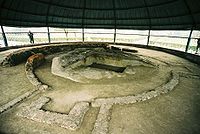 |
 |
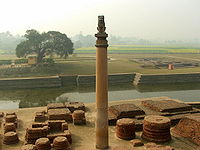 |
Relic stupa
Near the coronation tank is Stupa 1 or the Relic Stupa. Here the LicchaviLicchavi
Licchavi was an ancient kingdom in Nepal, which existed in the Kathmandu Valley from approximately 400 to 750. Centuries earlier, at the start of the Buddhist era a powerful republic known as Licchavi existed in what is today Bihar. There is no conclusive evidence of any ethnic or historic links...
s reverentially encased one of the eight portions of the Master's relics, which they received after the Mahaparinirvana. After his last discourse the Awakened One set out for Kushinagar
Kushinagar
Kushinagar , Kusinagar or Kusinara is a town and a nagar panchayat in Kushinagar district in the Indian state of Uttar Pradesh. It is an important Buddhist pilgrimage site, where Gautama Buddha is believed to have attained Parinirvana after his death.-Demographics: India census, Kushinagar had a...
, but the Licchavis kept following him. Buddha gave them his alms bowl but they still refused to return. The Master created an illusion of a river in spate which compelled them to go back. This site can be identified with Deora in modern Kesariya village, where Ashoka
Ashoka
Ashok Maurya or Ashoka , popularly known as Ashoka the Great, was an Indian emperor of the Maurya Dynasty who ruled almost all of the Indian subcontinent from ca. 269 BC to 232 BC. One of India's greatest emperors, Ashoka reigned over most of present-day India after a number of military conquests...
later built a stupa.
Kutagarasala Vihara
Kutagarasala Vihara is the monastery where Buddha most frequently stayed while visiting Vaiśālī. It is located 3 kilometres from the relic Stupa, and on its ground can be found the Ānanda Stupa, with an Asokan pillar in very good condition (perhaps the only complete Asokan pillar left standing), and an ancient pond.Coronation Tank
A few hundred metres from the Relic Stupa is Abhishek Pushkarini, the coronation tank. The sacred waters of the tank anointed the elected representatives of Vaiśālī.World Peace Pagoda
Next to the coronation tank stands the Japanese temple and the Viśvā Śānti Stūpa (World Peace PagodaPeace Pagoda
A Peace Pagoda is a Buddhist stupa designed to provide a focus for people of all races and creeds, and to help unite them in their search for world peace. Most have been built under the guidance of Nichidatsu Fujii , a Buddhist monk from Japan and founder of the Nipponzan-Myōhōji Buddhist Order...
) built by Japanese Nichiren Buddhist
Nichiren Buddhism
Nichiren Buddhism is a branch of Mahāyāna Buddhism based on the teachings of the 13th century Japanese monk Nichiren...
sect Nipponzan-Myōhōji
Nipponzan-Myohoji
Nipponzan Myōhōji , founded in 1917 by Nichidatsu Fujii, is a new religious movement that emerged from the Nichiren sect of Japanese Buddhism....
. A small part of the Buddha's relics found in Vaiśālī have been enshrined in the foundation and in the chhatra of the Stupa.

